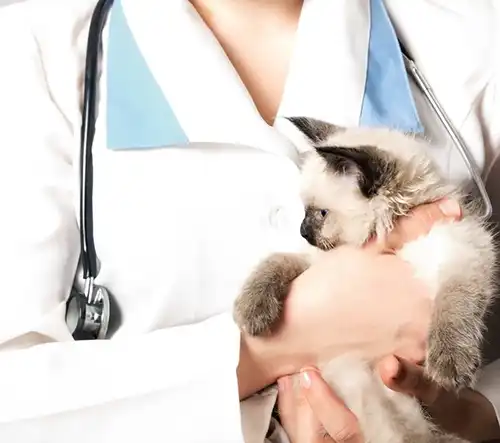Are you about to bring an adorable, bouncing little ball of fur into your home? Congratulations! Our feline pals are cute no matter what age they are, but they really are ridiculously adorable as babies. Getting a kitten is lots of fun! It’s also a lot of work. Cats are extremely mischievous at that age. You’ll need to do some petproofing to keep your tiny bundle of mischief safe as she explores and conquers her new kingdom. A local San Rafael, CA vet offers some kittenproofing tips in this article.
How Do I Kittenproof My House?
You may be surprised at how many ways a kitten can get herself into trouble. Quite a few everyday household items can be dangerous to a curious little ball of fur! You’ll need to carefully petproof your home to make sure that it is safe for your furry pal.
Without further adieu, here are the most critical things to address:
Toxic Plants: Kitties love to smell and nibble on plants, Unfortunately, many popular plants are quite dangerous for them. Lilies, for instance, can be deadly to our feline friends in even tiny doses. Little Fluffy only needs to take a sip of water or nibble on a leaf to get sick!
Here are a few other poisonous plants:
- Amaryllis
- Autumn crocus
- Oleander
- Tulips
- Hyacinth
- Sago palm
- Aloe
- Cyclamen
- Rhododendron
- Daffodils
- Dieffenbachia
- Chrysanthemum
- Azalea
- English ivy
- Widow’s-thrill
- Lily of the Valley
- Yew
- Castor bean
- Holly
- Mistletoe
- Poinsettia
- Hydrangea
Keep in mind that sometimes even safe plants pose a threat. For instance, spider plants are safe. However, you don’t want to place yours in a spot where your kitty could knock it over onto herself. Ask your San Rafael, CA vet for tips on this.
You can find a full list online at the ASPCA website here.
Ropes And Cords: We’ve all seen those cute photos and pictures of cats batting at ribbons and strings. This may be cute, but it’s actually very dangerous. Any type of thread or rope is extremely dangerous for kitties. For one thing, they pose choking and strangulation risks. If your pet were to swallow a cord or string, it could cause potentially fatal internal injuries. This is due to the way Fluffy’s digestive system is shaped. As ropes go through intestines, they can twist and pull things out of shape. (That is the nutshell version.)
Of course, it doesn’t help that cats are instinctively drawn to these things. Fluffy does sometimes seem most interested in the things that are dangerous for her! Keep items like drape cords, stringed hoodies, and wand toys well secured.
Small/Sharp Objects: Cats are born with an instinctive need to master their murder hunting skills. Fluffy will try to practice her ‘lioning’ on anything and everything within paws’ reach. While this is always charming to watch, it can also be dangerous. Anything small is a potential choking hazard. Sharp objects are also unsafe. Items that are both are definitely a no-no.
Here are a few of the things on that list:
- Beads
- Buttons
- Fishing Tackle
- Rubber bands
- Safety pins
- Craft Kit Pieces
- Jewelry
- Bobby pins
- Thumbtacks
- Small toys
- Hair ties
Plastic Bags: Plastic bags, wrappers, and ties are also dangerous. Your pet could get tangled up in a plastic bag. She may also try to lick or eat a wrapper, which could then choke her and/or cause extremely dangerous internal issues. Keep wrappers and ties out of reach of those tiny paws.
Chemicals: Basically, you should consider any sort of household cleaner toxic to kitties. Your pet only needs to walk through a puddle or treated patch to get sick: she’ll lick it off her fur or paws when cleaning herself. Cats can also easily absorb things through their skin. This list includes things like paint, cleaning agents, drain openers, automotive products, oven cleaner, bleach, and laundry detergent. Many lawn and garden chemicals are also unsafe.
Moving dangerous objects out of paws’ reach is quite easy: just keep these things put away when they aren’t in use. However, there are also a few things you would want to address about your house itself. First and foremost, make sure that your doors and windows close securely, and that your air vents are screwed in tightly. We would also recommend blocking off the openings behind and beneath furniture and cabinets. Kittens can fit into some pretty small spaces!
Another thing on the list? Get into the habit of keeping major appliances: especially toilets, washers, and dryers, closed when not in use. An adult cat would be able to get out of a toilet if they fall in, but a kitten could easily get trapped and drown. Dryers are another huge risk. It would be very easy for your furry little explorer to hop in when you aren’t looking!
When Can You Let A Kitten Roam Freely?
Every cat develops a bit differently, just as children do. Some of our feline pals are pretty good about staying in safer areas. Others will literally climb the walls and knock everything off your shelves. After bringing your little buddy home, keep your furry pal confined to a small area at first, particularly if you have a large house.
If you don’t have a separate room, you could keep Fluffy in a dog crate for the first few days, as long as she has toys, food, water, bedding, and a litterbox. Once your little buddy has settled in, you can slowly let her roam more and more, until she has free reign of her new empire. Ask your vet for more information.
Of course, we don’t ever recommend letting a kitten go outdoors … even when she’s all grown up!
How Do I Keep My Kitten Safe?
Aside from the petproofing suggestions we’ve gone through here, we would also very, very strongly recommend keeping your cat indoors. Kitties that are allowed to wander face some very serious hazards, such as weather, traffic, wild animals, chemicals, stray cats, loose dogs … the list goes on. In fact, keeping your cute little furball indoors is one of the best things you can do for her.
You definitely have the upper paw on this if Fluffy is still a baby: kitties that were raised inside tend to accept that the outdoors is off-limits much more easily than a cat that has been allowed to come and go. Making your home fun and interesting by incorporating things like cat furniture, toys, and beds can also help eradicate your feline pal’s desire to go out.
You’ll also want to get into the habit of just keeping an eye on your little buddy. Kittens can fit into some very dangerous spots that are hard to block off, such as the openings under recliners or between couch cushions. Little Fluffy also won’t make a very big lump if she curls up under a blanket. Pay attention to your furry pal’s whereabouts.
Finally, be sure to bring your furry pal in to your San Rafael, CA animal clinic regularly. Proper veterinary care is crucial to your pet’s health and well-being. We love watching kittens grow from adorable little furballs into happy, healthy adult cats!
Set An Appointment At Your San Rafael, CA Pet Clinic
Do you have questions about your kitten’s health or care? Please feel free to contact us, your local San Rafael, CA pet hospital, any day!







!Social Media Icons